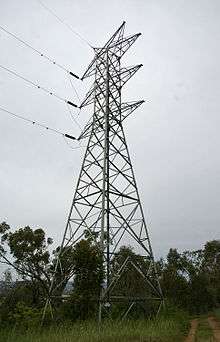Electricity Commission of New South Wales

The Electricity Commission of New South Wales, sometimes called Elcom, was a statutory authority responsible for the generation of electricity and its bulk transmission throughout New South Wales, Australia. The Commission was established on 22 May 1950 by the Electricity Commission Act 1950 and its role was to take control of power generation from the County Councils (such as the Sydney County Council) and the New South Wales Government Railways, who until that time were responsible for power generation and distribution. It acquired the power stations and main transmission lines of the four major supply authorities (Southern Electricity Supply, Sydney County Council, the Department of Railways and the Electric Light and Power Supply Corporation Ltd, known as the Balmain Company).[1] The commission was responsible for the centralised co-ordination of the state's electricity generation and supply.
Upgrading and expansion of the power station network
Between 1950 and 1960, the commission more than tripled power capacity, from 490 megawatts to 1800. At first, this involved completing the expansions of Bunnerong, White Bay, Balmain, and Pyrmont, and completing new stations already designed by the Department of Railways: Tallawarra near Port Kembla (1954), Wangi, at Lake Macquarie (1956), and Wallerawang, near Lithgow (1957).[2]
The Electricity Commission adopted the trading name Pacific Power in 1992.
Breakup and reform
In the early 1990s, Australian state governments began to deregulate state owned monopoly electricity commissions in order to promote competition, customer choice and potentially cheaper electricity.[3] In 1992 the coal mines owned and operated by the electricity commission of NSW (ELCOM Collieries) was split off into a new government organanisation called Powercoal. In 1995, the transmission assets were split off into a new government organisation called TransGrid, and new distributors and retailers set up. In 1996, two new entities were split off - Delta Electricity and Macquarie Generation. In 2000, the remaining power stations were transferred to a new entity, Eraring Energy, and the consulting business sold to Connell Wagner. The privatisation of the State's electricity assets proposed in 1997 [4] began a long running controversy which extended well into the twenty-first century.
References
- ↑ "Electricity Commission of New South Wales". NSW Department of Records. Archived from the original on 30 August 2007. Retrieved 28 September 2007.
- ↑ "Conde, Harold Graydon". Australian Dictionary of Biography. Retrieved 28 September 2007.
- ↑ "Electricity Deregulation Outside the New South Wales and Victorian Markets" (PDF). Roarty, M. Retrieved 28 September 2007.
- ↑ Treasury Briefing Paper, 17/1997